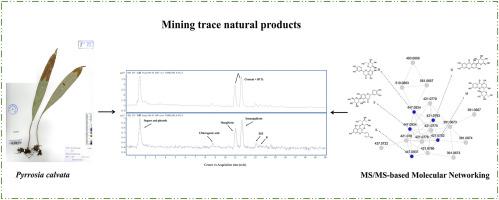Mining of trace natural products from Pyrrosia calvata with feature-based molecular network strategy
IF 2
4区 生物学
Q4 BIOCHEMISTRY & MOLECULAR BIOLOGY
引用次数: 0
Abstract
Pyrrosia calvata is a traditional Chinese medicinal fern endemic to Guangxi, China. However, its phytochemical profile remains largely unexplored, and the comprehensive characterization of its chemical constituents is still lacking. In this study, the ethanolic crude extract of P. calvata was analyzed using ultrahigh-performance liquid chromatography coupled with quadrupole time-of-flight mass spectrometry (UPLC-QTOF-MS) in both negative and positive ionization modes, employing a data-dependent acquisition (DDA) strategy. The acquired data were processed using MS-DIAL and further analyzed through the Feature-Based Molecular Networking (FBMN) workflow on the Global Natural Products Social (GNPS) platform to facilitate the discovery and annotation of both known and putatively novel natural products. As a result, fourteen compounds were identified or tentatively characterized, with flavonoids representing the predominant chemical class. Notably, eleven of these compounds were reported for the first time from P. calvata. The results demonstrate the effectiveness of FBMN-assisted metabolomics in expanding the chemical coverage of trace constituents and provide a foundation for future targeted isolation and pharmacological evaluation of bioactive compounds from this medicinal fern.

基于特征的分子网络策略在红土中痕量天然产物的挖掘
野蔷薇(pyrosia calvata)是中国广西特有的一种中药蕨类植物。然而,其植物化学特征在很大程度上仍未被探索,其化学成分的综合表征仍然缺乏。在本研究中,采用超高效液相色谱-四极杆飞行时间质谱(UPLC-QTOF-MS),采用数据依赖采集(DDA)策略,在负离子和正离子模式下分析了牛角草乙醇粗提物。获取的数据使用MS-DIAL进行处理,并通过Global Natural Products Social (GNPS)平台上基于特征的分子网络(Feature-Based Molecular Networking, FBMN)工作流进行进一步分析,以促进已知和假定的新天然产物的发现和注释。结果,鉴定或初步鉴定了14个化合物,其中黄酮类化合物为主要化学类。其中11个化合物为首次从该植物中分离得到。结果表明,fbmn辅助代谢组学在扩大微量成分的化学覆盖范围方面是有效的,为今后从该药用蕨类植物中靶向分离和评价生物活性化合物提供了基础。
本文章由计算机程序翻译,如有差异,请以英文原文为准。
求助全文
约1分钟内获得全文
求助全文
来源期刊

Biochemical Systematics and Ecology
生物-进化生物学
CiteScore
3.00
自引率
12.50%
发文量
147
审稿时长
43 days
期刊介绍:
Biochemical Systematics and Ecology is devoted to the publication of original papers and reviews, both submitted and invited, in two subject areas: I) the application of biochemistry to problems relating to systematic biology of organisms (biochemical systematics); II) the role of biochemistry in interactions between organisms or between an organism and its environment (biochemical ecology).
In the Biochemical Systematics subject area, comparative studies of the distribution of (secondary) metabolites within a wider taxon (e.g. genus or family) are welcome. Comparative studies, encompassing multiple accessions of each of the taxa within their distribution are particularly encouraged. Welcome are also studies combining classical chemosystematic studies (such as comparative HPLC-MS or GC-MS investigations) with (macro-) molecular phylogenetic studies. Studies that involve the comparative use of compounds to help differentiate among species such as adulterants or substitutes that illustrate the applied use of chemosystematics are welcome. In contrast, studies solely employing macromolecular phylogenetic techniques (gene sequences, RAPD studies etc.) will be considered out of scope. Discouraged are manuscripts that report known or new compounds from a single source taxon without addressing a systematic hypothesis. Also considered out of scope are studies using outdated and hard to reproduce macromolecular techniques such as RAPDs in combination with standard chemosystematic techniques such as GC-FID and GC-MS.
 求助内容:
求助内容: 应助结果提醒方式:
应助结果提醒方式:


